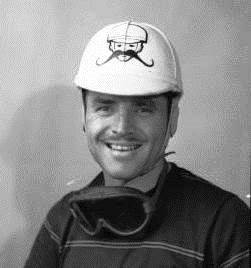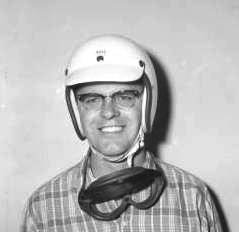Two works by the
master - Emil Diedt
color photos by the author
black & white photos appear courtesy of the Indianapolis Motor Speedway Collection in the IUPUI University Library Center of Digital Studies
During a recent visit to the World of Speed museum to view
the special Indianapolis ‘500’ exhibit, the author photographed two automotive
works of art built by one of the sport’s master metal craftsmen. Emil Diedt, born
in Germany in 1897 worked out of a shop in Culver City California and was best known as the builder of the
identical pair of 270-cubic inch Offenhauser powered front wheel drive cigar-shaped ‘Blue
Crown Spark Plug Specials’ owned by retired driver Lou Moore, but Diedt built two more similar cars later.
Reputedly the advantage of the front wheel drive at the Indianapolis
Motor Speedway was due to more weight centered over the driving wheels which helped
to “pull” the car through the corners and reduced the car’s tires sliding once
the track surface got slippery with oil during the race. This proved to be
correct, as front wheel drive cars led every lap of the 1947 500-mile race.
The new Blue Crown cars debuted at the 1947 Indianapolis
500-mile race, qualified in third and eighth positions and then dominated the
race, leading 177 laps. With 100 miles
to go and his cars running in first and second positions, Moore signaled to the
drivers of his cars via the pit board “EZY” the signal for the pair to take it
easy. With just eight laps to go the race leader 39-year old rookie Bill
Holland waved his teammate, Mauri Rose past him as Holland thought he held a one-lap
lead. Holland was mistaken and Rose
raced away to score his second (and first solo) Indianapolis victory as the angry
Holland finished 32 seconds behind Rose.
1949 '500' winner Bill Holland
In 1948, the ‘Blue Crowns’ repeated their domination, with
Rose and Holland again finishing one-two over two minutes ahead of the third
place finisher, the front wheel drive Novi driven by Dennis ‘Duke’ Nalon. In
1949, Holland finally won the ‘500’ as Mauri Rose’s car broke a magneto strap
while he ran in second place with eight laps to go. After a month of ongoing
disputes with car owner Moore, the outspoken Rose angrily quit the team, or was
fired, depending on whose version one chose to believe.
The Keck car
The immediate success of the Diedt-built front wheel drive
‘Blue Crowns’ led to other car owners looking for their own versions. One such
car owner was Southern Californian Howard B. Keck, heir to the Superior Oil
fortune. Keck earlier purchased John Balch’s Offenhauser powered midget racing
operation together with the services of co-chief mechanics Jim Travers and
Frank Coon and their friend fuel injection pioneer Stuart Hilborn. After
dominating in United Racing Association (URA) ‘red’ circuit for Offenhasuer
powered cars, the Keck team and was ready to conquer Indianapolis.
With Keck’s backing, Travers and Coon ordered a new front
wheel drive chassis from Emil Diedt for the 1948 Indianapolis ‘500.’
Indianapolis native son Jimmy Jackson who scored two top-five finishes in the 1946 and 1947 500-mile
races, qualified the new #61 ‘Howard Keck Special’ at 127.51 miles per hour
(MPH) for the fourth positon. After he started the race on the inside the
second row behind Rex Mays, Rose and Holland, Jackson ran just outside the top five for most
of the race, but his good finish was spoiled when a wheel spindle broke on the maroon colored machine with
six laps to go and he spun into the infield.
Jackson and the Keck team returned to Indianapolis in 1949; Jackson wanted to paint the car green but Keck refused so Jackson wore green gloves. The ground-breaking Hilborn fuel-injected ‘Howard Keck Special’ started seventh after Jackson qualified with a
four-lap average of 128.023 MPH. At the end of the 500-mile test, the #61 Diedt
front wheel drive machine finished sixth, seven minutes behind winner Hollard’s
similar machine.
Mauri Rose adds Pennzoil in this 1951 publicity shot
For the 1950 Indianapolis 500-mile race, former ‘Blue Crown’
pilot Rose was the new driver of the Keck/Offenhauser front wheel drive Diedt machine
and Mauri qualified with a four-lap
average of 132.319 MPH to start on the outside of the front row. Rose earned a
measure of revenge as he out-qualified both of the Moore ‘Blue Crowns;’ Holland
was tenth fastest and Rose’s replacement, Tony Bettenhausen timed in eighth
fastest.
Rose and the Keck entry led the race on three occasions for
a total of 15 laps, but Rose was slowed when he was briefly forced out of the
cockpit by a pit fire on his only stop on lap 109. Rose had pitted from the lead and once the fire was extinguished Mauri was back underway
and he recovered to finish third behind Holland in a controversial rain-shortened
138-lap race. The deluge lasted just 60 seconds, but Speedway officials stopped the race and initially scoring was very confused, with Rose originally unofficially scored in fifth place. The #31 Keck entry’s appearance in race footage of the 1950
Metro-Goldywn-Mayer film ‘To Please a Lady’ was little satisfaction for Rose who
lost his chance to become the first Indianapolis 4-time winner.
For the 1951 Indianapolis 500-mile race the Emil Diedt
bodywork was painted black with yellow and red trim and the #16 car carried
Pennzoil sponsorship. Mauri Rose, who turned 45 years old four days before the
race, qualified fifth fastest at 133.422 MPH to start from the middle of the
second of eleven rows of three. In his 15th Indianapolis ‘500’ on his 127th
lap, while Rose ran in third place, the right rear wire wheel of the ‘Pennzoil
Special’ collapsed. Rose fought for control as the car slid into the infield
off turn two and into a drainage ditch where it overturned and momentarily
trapped Mauri underneath.
The aftermath of the 1951 flip
Legend has it that Rose retired from racing on the spot, but
in actuality, it was the death of Rose’s first wife and mother of his two young
children Mauri Junior and Dory who both were polio survivors during the winter
of 1951 that lead Mauri to formally announce his retirement. On January 30 1952, from his home in Van Nuys California,
Rose told reporters that after 24 years, he could no longer risk his life
racing.
The 1951 Indianapolis ‘500’ marked the final race appearance
of the Howard Keck owned Emil Diedt front wheel drive machine, as the following
year the Keck team entered a 270-cubic inch Ferrari 375 and a new
Offenhauser-powered creation from Frank Kurtis known as the 500A but nicknamed the
“roadster.” The Diedt car as displayed at the Museum of Speed is expertly
restored as how the car appeared in the 1951 Indianapolis ‘500.’
Reputed Chicago suburban south side organized crime figure Carmine George “Babe”
Tuffanelli became interested in automobile racing and owned several beautifully maintained ‘big cars’ and midgets which raced in events
across the country. The team of cars, each fielded as ‘Tuffy’s Offy’ were
maintained by experienced mechanic Charles Pritchard from a garage on Vincennes
Avenue in the Chicago suburb of Rock Island Illinois assisted by a young
mechanic named Ray Nichels.
From 1948 through 1950 Pritchard and Tuffanelli entered
Kurtis-Kraft 2000 upright dirt cars in the Indianapolis 500-mile race, but for
the 1950 running of the International Classic, the team entered their new Emil
Diedt built front wheel drive chassis dubbed the ‘Tuffanelli-Derrico Special’.
The second name car on the car was one of Carmine’s alleged underworld business
associates, Jimmy Derrico, who became part-owner of the ¼-mile Raceway Park in
Blue Island in 1952.
For Tuffanelli’ s car Diedt make extensive use of aluminum
including the oil and fuel tanks to make the new front wheel drive car 350
pounds lighter than previous versions. For the driver of the new maroon and
gold Diedt creation for the 1951 ‘500’ Pritchard and Tuffanelli selected their
1950 driver, the mustachioed California midget racing standout Ronald “Mack”
Hellings. Mack originally a motorcycle racer
came up through the URA midget ranks with such future Indianapolis stars as
Bill Vukovich and Sam Hanks and was crowned the 1948 champion of the URA ‘Blue’
Circuit for non-Offenhauser powered machines.
Mack Hellings official IMS head shot
Hellings graduated to championship cars during 1948 and
drove for two seasons for the Los Angeles–based Don Lee racing team before he
jumped to the “Tuffy’s Offy” team for 1950 and he scored five top ten finishes
in nine starts in a K-K 2000 during the 1950 AAA (American Automobile Association)
racing season . When not racing,
Hellings ran an automotive and motorcycle speed shop first located in North
Hollywood and later Burbank California
Helling's company logo
At Indianapolis in 1951, two days before the first weekend of time trials, the ‘Tuffanelli-Derrico Special’ lost a camshaft bearing. On the third day of time trials,
Hellings could only record a four-lap average speed of 123.925 MPH, which held up
although his speed was nearly seven-and- a-half miles per hour slower than the
next slowest qualifier. On race day, Hellings and the new Diedt creation started from the middle of the eight row, but only
completed eighteen laps before the car was retired with a broken piston in the
270-cubic inch Offenhauser engine.
Hellings did not get a second chance to drive the ‘Tuffanelli-Derrico
Special’ at the Indianapolis Motor Speedway. On Sunday, November 11 1951, Hellings, fellow
URA racer and engine builder Bob Baker, and URA photographer George “Lee”
Harvey left Brackett Field near LaVerne in a rented plane piloted by Robert
Harris. The quartet were headed north for the ‘Bay Meadows 150’ the final 1951
season championship car race scheduled for that evening at Bay Meadows race
track in San Mateo.
A typical Piper Pacer
The cream-colored single-engine Piper PA-20 Pacer tail number N74568K
was overdue for their mid-day fuel stop in Fresno and after the plane failed to
arrive overnight, search parties were dispatched. On November 15 the wreckage
of the plane and the four deceased passengers was found near the 4000-foot
elevation on the south slope of the Tehachapi Mountains near Gorman California.
Contemporary legend has it that Tuffanelli was so devastated
over Hellings’ death that the car never raced again but the ‘Tuffanelli-Derrico Special’ was
entered for the 1952 Indianapolis ‘500.’ The 1951 driver was Chicago journeyman
midget racer Danny Kladis (sometimes spelled Cladis) who had started racing ‘big cars’ before World War Two.
Kladis was the Mississippi Valley Midget
Racing Association (MVMRA) driving champion three consecutive seasons from 1946
through 1948. Despite his Hall of Fame midget career, Danny experienced tough times
at the Indianapolis Motor Speedway, and only qualified for the ‘500’ once in seven years of trying.
It is unclear whether Kladis made a qualifying attempt after he spun the car out of turn two on May 15, and the ‘Tuffanelli-Derrico Special’ never appeared again for competition at
the Indianapolis Motor Speedway. The beautiful #19 Emil Diedt-built ‘Tuffanelli-Derrico
Special’ on display at the World of Speed museum appeared to be in original
unrestored condition sporting its striking trademark gold-leaf nose scallop and
numbers outlined in red pinstriping.
Although they scored three consecutive 500-mile race
victories and three runner-up finishes in four years, the reign of the Emil Diedt
built front drive race cars at the Indianapolis Motor Speedway was over after
just five years. With the early
retirement of the ‘Blue Crown Special’ driven by Tony Bettenhausen from the
1952 ‘500,’ the front wheel drive concept was replaced by the next generation
of Indianapolis race cars, the lighter weight “roadsters.”
The World of Speed
museum located at 27490 SW 95th Avenue in Wilsonville Oregon will feature their
“Celebration of the 100th running of the Indianapolis 500-mile race” exhibit through
April 2017.




























